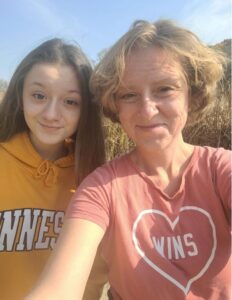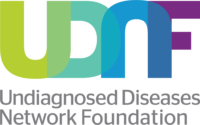25 Jan Sarah Marshall
 Phoebe, now nearly 13 years old, was first evaluated by the UDN in April 2017. It’s been four years and, like for so many others, information has been slow in coming. The timeline is blurred in my memory in a way that is likely familiar to many UDN participants: in person evaluation with blood drawn for exome sequencing, followed by a long wait for results that showed nothing. Then, genome sequencing with a long wait that ended for us with two possible gene candidates. Again, I was told that we would have to wait until it was determined whether either gene mutations could be examined by the Model Organisms Screening Core (MOSC). Months later, I was notified that GDF11 was going to be taken up by the MOSC. It struck me that this was exciting information, but I lacked a full understanding about what it actually meant, and what was involved in this process. Of course, being the parent that I am, all the while, I sent at least monthly emails inquiring as to the status of what I came to call “my daughter’s gene.” I also read and reread all articles I could find on GDF11. So much of the vocabulary in scientific journal articles was above my head, which is precisely why I read each article at least three times. I would painstakingly look up every vocabulary word I did not know and study every scientific diagram of gene pathways that I came across. I willed myself to understand all that I possibly could, to possess some depth of knowledge. I hoped that I could somehow tie my daughter’s experience and her many rare diagnoses she had collected along the way to GDF11. I wanted it to make sense. I wanted an answer.
Phoebe, now nearly 13 years old, was first evaluated by the UDN in April 2017. It’s been four years and, like for so many others, information has been slow in coming. The timeline is blurred in my memory in a way that is likely familiar to many UDN participants: in person evaluation with blood drawn for exome sequencing, followed by a long wait for results that showed nothing. Then, genome sequencing with a long wait that ended for us with two possible gene candidates. Again, I was told that we would have to wait until it was determined whether either gene mutations could be examined by the Model Organisms Screening Core (MOSC). Months later, I was notified that GDF11 was going to be taken up by the MOSC. It struck me that this was exciting information, but I lacked a full understanding about what it actually meant, and what was involved in this process. Of course, being the parent that I am, all the while, I sent at least monthly emails inquiring as to the status of what I came to call “my daughter’s gene.” I also read and reread all articles I could find on GDF11. So much of the vocabulary in scientific journal articles was above my head, which is precisely why I read each article at least three times. I would painstakingly look up every vocabulary word I did not know and study every scientific diagram of gene pathways that I came across. I willed myself to understand all that I possibly could, to possess some depth of knowledge. I hoped that I could somehow tie my daughter’s experience and her many rare diagnoses she had collected along the way to GDF11. I wanted it to make sense. I wanted an answer.
Two years passed. Along the way, I was told that the MOSC’s first experiment seemed to confirm their diagnostic suspicions, but another round of experiments needed to be done before drawing any conclusions. In the fall of 2020, I was notified that the results of the second study were consistent with the first and that a manuscript was being written to be submitted to a scientific journal. The news was thrilling, but the lack of details left me hungry for more information. I reached out to my genetic counselor more frequently, asking if the team would share a copy of the manuscript with me. I was told that I would have to wait for publication. Meanwhile, my daughter began to develop new symptoms that her doctors at home were having a hard time explaining. So I reached out to the genetic doctor at the UDN site to pick her brain about Phoebe’s new symptoms…and to ask if she would share the manuscript with me. Again, I was told that it was not possible.
Finally, one day I mentioned to Paul Mazur of the Coordinating Center my frustration with being unable to access this manuscript. Paul knew someone at the MOSC and asked me if it was okay that he reached out to his contact. “Of course,” I told him. From there, things unfolded quickly. As it turned out, Paul’s contact was one of the manuscript’s authors. He shared it with me with the request that I not share the article publicly until it reached publication. “Of course,” I told him. After reading the manuscript at least three times—so that I could look up every vocabulary word, like I do – I mentioned to Paul that I would love to talk with the researchers. Paul relayed this and before I knew it, a virtual meeting was held between myself and three of the authors.
It was nothing short of amazing. Thomas Ravenscroft, a graduate student under Dr. Hugo Bellen at Baylor College of Medicine, gave a PowerPoint presentation that explained, step by step, the research that was conducted and its findings. It was thrilling to be able to ask detailed questions about their findings and get answers from the researchers themselves. As much as I felt engaged with these scientists, I could feel how engaged they were with me and how keenly interested they were in Phoebe’s story. The synergy between the four of us was palpable and delightful. Our call ended with my full understanding that these were not just findings in some abstract research activity, not just some manuscript being submitted for the benefit of the annals of science. This was the end my daughter’s diagnostic odyssey. This was a diagnosis. Now the odyssey for a cure can begin. Of course.



